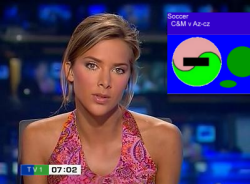Media in Candelaria And Marquez
Candelaria And Marquez possesses a relatively small but powerful media, that enjoys a greater degree of influence that in other western nations owing to the low uptake of internet use. Though guaranteed free by the constitution; many broadcasters defer to the government of the day on decisions of whether certain events – particularly those taking place overseas – are in the ‘public interest’, and are known to be leaned upon at times to do so. State-funding for certain entities has been removed and reinstated at times after the broadcast of programmes or articles deemed by the government or media watchdogs to overstep lines of decency or display certain ‘adverse opinions’; though criticism of politicians and the social status quo is seldom clamped down upon in any obvious way.
Newspapers
- Main article(s): Newspapers in Candelaria And Marquez
Candelariasians are vociferous readers of the country's limited number of daily papers, with the dominant forces being the Berliner-format Albrecht Herald, sympathetic to the leftist establishment, and the sensationalist tabloid Albrecht Mercury. Various publications vie for the country's right-leaning readership, including the Albrecht Daily News, El Periodico del Arrigo (the country's most popular Spanish-language newspaper) and the Bove National Reporter. The Daily Worker remains popular, though primarily for ironic value, while the Khatib-based The Candelariasian provides a less blinkered Socialist view.
A high proportion of citizens outside of the major cities also take a local paper which can generally be counted upon to provide a wide spectrum of opinion. These have risen notably in popularity in recent years, with Candelariasians relying increasingly on the television, radio and internet for up-to-the-minute news reporting; leaving the traditional papers to increasingly specialise in opinion pieces and editorials. Popular local publications include the Clotaire Trumpet, Noticias en las islas (Bass) and The Patriot (Maidment).
Radio
All major radio stations are commercial, but are or have been linked to the official state broadcaster Candelarias Radio Corporation. With the exception of Radio One, the "grown-up voice" of C&M; all stations began life as localised entities, taking only a smattering of programming provided by the CRC. A small number have achieved national coverage and popularity; such as RadioZeroAlvery, "the nation's local radio station", that has the most popular breakfast show in the country and is highly influential in the field of new music both domestic and foreign.
An internet-based station, C&M-Live, was made available from the Foreign Office's website in 2005 for the use of Candelariasian ex-pats. A mix of exclusive programming and highlights from stations across the country; it has rapidly become popular within the islands themselves.
Television
- Main article(s): Television in Candelaria And Marquez
The now-defunct Candelarias Broadcasting Corporation was established in 1953, to bring together several independent radio networks under one banner and establish the country's first national television station. The early CBC (which should not be confused with the Cookeslandic Broadcasting Corporation) was heavily influenced by the rapidly rising power of the Socialist Party, and by the time of James McManus' second electoral victory of early 1959 it was all but under their complete control. The corporation was re-established in 1963, with a new and more thorough public service charter. CandelariasTelevision later split in 1975 to become the modern entities of TV1 and TV2, though the programming make-up of both state channels has changed somewhat over the years.
Acknowledging the seemingly inevitable rise of commercial networks; TV1 was established to provide 'quality', advert-free, family-friendly programming providing for all tastes, ages and cultures. In practise, the station struggled manfully through under-funding and a certain degree of mismanagement; spending over its budget on high-end, but largely unpopular, dramas, documentaries and news programmes seen today in hindsight as woefully pretentious. Its schedule was filled up with cheap imports from regional neighbours, TV1's management taking advantage of Rushmori free-trade agreements to sign up the Riikian sitcoms, Chesapeake Bay crime thrillers, Switzish cookery shows and nature documentaries from the land of Ecological Fairness; that provided the staple of mid-Seventies Candelarias TV-viewing. Many of these shows and their descendents remain popular today; though have been long-since shifted onto TV2, a station now almost entirely consisting of foreign imports though these now include a hotchpotch of critically-acclaimed efforts from much larger and wealthier countries than before.
Real innovation during this period was left to a succession of short-lived commercial channels. The Restoration Group, still the country's highest-grossing television export, began on National-5TV in the early eighties. Genuinely sinister and morally ambiguous in a way only kids' programmes can be, TRG's 219 lovingly papier-mâché forged animated episodes followed the travels of two disaffected children in a mystical land as they joined up with a terrorist organisation bent on protecting the traditional way of life of several mutually antagonistic peoples and species from a dictatorial New Order. Its most memorable creations, mind-reading bat-people called the Canoueuaxak, and the other inhabitants of the World Cone; have terrified generations of Candelariasian children, and been watched by millions of adolescent Goths, druggies and fantasy enthusiasts across the Multiverse.
For several years, N-5TV also held the broadcasting rights to the country's longest-serving soap Home Is Where the Harts Are (later ...Hart Is), which has always maintained huge ratings (as often for its ironic value as anything else) with its portrayal of the massively multicultural, if otherwise laughably traditional, fictional town of Home. It is now shown once more on TV1, alongside Holy Road, a brasher soap rather less popular through being considerably better acted and more realistic.
TTO (Telisman Television Organisation, and based like its state siblings in the city of Bove) is currently the largest independent network, known for its cheap sets and expensive idents. Its status is being rapidly challenged by Onwere TV however, a station operating out of the city's university and respected for its innovative programming and relaxed presentation style that other more staid networks are increasingly seeking to emulate. Perhaps OTV’s greatest achievement was in winning the rights to the CMSC weekly highlights package, a move which came after a year in which the station featured a cult spoof sports discussion show.
Critics remain divided as to whether the advent of "reality-TV" in the islands has enriched the country's televisual landscape, or damaged it beyond repair. Certainly its success cannot be understated - versions of Big Brother, Dancing with the Stars and the aforementioned C&M Idol have proved wildly popular, along with home-grown formats such as Political Idol, which spawned the Independent Representation Party in 2003.
Candelariasians' average amount of television viewing has increased dramatically in recent years, but still lags behind most other Western nations and there remains no particular culture
All developed countries have a news reader who looks
like this. There's a factory, somewhere.

style, as witnessed here by Rich Stevens
and Jenny Koçgündüz on the Evening News
The four main stations are constitutionally obliged to provide dubbing, subtitles and/or alternative programming in Spanish. Exclusively Spanish-language networks make up almost half of the country's total number of local and specialist channels.
News
On TV1 and TTO, news programmes are generally limited to bulletins and frothy discussion shows. It has been the practise on television since the medium's earliest days in the islands for news anchors to merely report the day's events in a calm style, with little or no personal input and expressing no deeply-held opinions of their own; despite the fact that such individuals have frequently become well-known, popular and respected faces. In direct contrast, newspaper columnists and radio talk show hosts are expected to present an often highly one-sided version of news stories.
C&M's major broadcasters have a competent reputation in investigative journalism, both at home and abroad, though in resent years concerns have been raised over press freedom and on certain social issues many newspapers and TV stations are known to practice self-censorship. Overseas, the death of the much-respected war reporter Russell Mylward during a 2004 European conflict has seen many broadcasters take a significantly less gung-ho approach to covering external affairs.
International Television
The C&M government has recently begun to encourage the presence of foreign broadcasters such as LBG and PINA in the country for the first time in decades, a move criticized by opposition parties and domestic networks as an expensive and unnecessary edition to an already strong market. These have likewise become based in Bove's Media City.
